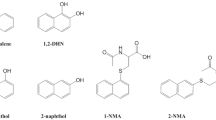Abstract
Urinary benzene, toluene, ethylbenzene, and xylenes (BTEX) can be used as a reliable biomarker of exposure to these pollutants. This cross-sectional study aimed to employ biomonitoring to assess BTEX exposure among South Pars Gas Field (SPGF) workers in Assaluyeh, Iran. Forty employees who were working on the site were recruited as the case group. Besides, 31 administrative employees were recruited as the control group. Pre-shift and post-shift spot urine samples were collected from the subjects in the case group, while the subjects in the control group provided mid-morning urine samples. Overall, 111 urine samples, including 80 samples from the case group and 31 samples from the controls, were collected. Gas chromatography-mass spectrometry (GC/MS) was used to determine the urinary levels of BTEX compounds. The median urinary levels of benzene, toluene, ethylbenzene, m,p-xylene, and o-xylene in the post-shift samples of the exposed group were 1.24, 2.28, 0.5, 1.32, and 1.5 μg/l, respectively. Significant differences were observed in urinary BTEX levels among smokers and non-smokers in both studied groups (p < 0.05). Accordingly, the median urinary BTEX concentrations in smokers were 2 to 6.5 times higher than the corresponding values in non-smoker subjects. Smoking status was the only predictor of the urinary BTEX concentration. Our findings revealed that refinery workers are exposed to significant levels of BTEX compounds. Considering the health risks associated with BTEX exposure for refinery workers, implementation of suitable control strategies, such as using appropriate personal protective equipment and improving on-site ventilation systems, are recommended reducing their exposure to BTEX via the inhalation.



Similar content being viewed by others
References
Abbasi F, Pasalari H, Delgado-Saborit JM, Rafiee A, Abbasi A, Hoseini M (2020) Characterization and risk assessment of BTEX in ambient air of a Middle Eastern City. Process Saf Environ Prot 139:98–105
Barbieri A, Violante FS, Sabatini L, Graziosi F, Mattioli S (2008) Urinary biomarkers and low-level environmental benzene concentration: assessing occupational and general exposure. Chemosphere 74:64–69
Barros N, Carvalho M, Silva C, Fontes T, Prata JC, Sousa A, Manso MC (2019) Environmental and biological monitoring of benzene, toluene, ethylbenzene and xylene (BTEX) exposure in residents living near gas stations. J Toxic Environ Health A 82:550–563
Becker K, Conrad A, Kirsch N, Kolossa-Gehring M, Schulz C, Seiwert M, Seifert B (2007) German Environmental Survey (GerES): human biomonitoring as a tool to identify exposure pathways. Int J Hyg Environ Health 210:267–269
Blount BC, Kobelski RJ, McElprang DO, Ashley DL, Morrow JC, Chambers DM, Cardinali FL (2006) Quantification of 31 volatile organic compounds in whole blood using solid-phase microextraction and gas chromatography–mass spectrometry. J Chromatogr B 832:292–301
Brajenović N, Karačonji IB, Bulog A (2015) Evaluation of urinary BTEX, nicotine, and cotinine as biomarkers of airborne pollutants in nonsmokers and smokers. J Toxic Environ Health A 78:1133–1136
Campo L, Rossella F, Mercadante R, Fustinoni S (2015) Exposure to BTEX and ethers in petrol station attendants and proposal of biological exposure equivalents for urinary benzene and MTBE. Ann Occup Hyg 60:318–333
Cattaneo A, Taronna M, Consonni D, Angius S, Costamagna P, Cavallo DM (2010) Personal exposure of traffic police officers to particulate matter, carbon monoxide, and benzene in the city of Milan, Italy. J Occup Environ Hyg 7:342–351
Chao CY, Chan GY (2001) Quantification of indoor VOCs in twenty mechanically ventilated buildings in Hong Kong. Atmos Environ 35:5895–5913
Chen WH, Chen ZB, Yuan CS, Hung CH, Ning SK (2016) Investigating the differences between receptor and dispersion modeling for concentration prediction and health risk0 assessment of volatile organic compounds from petrochemical industrial complexes. J Environ Manag 166:440–449
Crebelli R, Tomei F, Zijno A, Ghittori S, Imbriani M, Gamberale D, Martini A, Carere A (2001) Exposure to benzene in urban workers: environmental and biological monitoring of traffic police in Rome. Occup Environ Med 58:165–171
Delgado-Saborit JM, Aquilina NJ, Meddings C, Baker S, Vardoulakis S, Harrison RM (2009) Measurement of personal exposure to volatile organic compounds and particle associated PAH in three UK regions. Environmental science & technology 43:4582–4588
DPHHS U (2005) Agency for Toxic Substances and Disease Registry (ATSDR). Toxicological profile for zinc (update). US Department of Public Health and Human Services. Public health Service, Atlanta, pp 1–2
Fustinoni S, Rossella F, Campo L, Mercadante R, Bertazzi PA (2010) Urinary BTEX, MTBE and naphthalene as biomarkers to gain environmental exposure profiles of the general population. Sci Total Environ 408:2840–2849
Fustinoni S, Campo L, Mercadante R, Consonni D, Mielzynska D, Bertazzi PA (2011) A quantitative approach to evaluate urinary benzene and S-phenylmercapturic acid as biomarkers of low benzene exposure. Biomarkers 16:334–345
Heibati B, Pollitt KJG, Charati JY, Ducatman A, Shokrzadeh M, Karimi A, Mohammadyan M (2018) Biomonitoring-based exposure assessment of benzene, toluene, ethylbenzene and xylene among workers at petroleum distribution facilities. Ecotoxicol Environ Saf 149:19–25
Hopf NB, Kirkeleit J, Bråtveit M, Succop P, Talaska G, Moen BE (2012) Evaluation of exposure biomarkers in offshore workers exposed to low benzene and toluene concentrations. Int Arch Occup Environ Health 85:261–271
Hoseini M, Yunesian M, Nabizadeh R, Yaghmaeian K, Parmy S, Gharibi H, Faridi S, Hasanvand MS, Ahmadkhaniha R, Rastkari N (2016) Biomonitoring of tobacco smoke exposure and self-reported smoking status among general population of Tehran, Iran. Environ Sci Pollut Res 23:25065–25073
Hoseini M, Nabizadeh R, Delgado-Saborit JM, Rafiee A, Yaghmaeian K, Parmy S, Faridi S, Hassanvand MS, Yunesian M, Naddafi K (2018) Environmental and lifestyle factors affecting exposure to polycyclic aromatic hydrocarbons in the general population in a Middle Eastern area. Environ Pollut 240:781–792
Imbriani M, Ghittori S (2005) Gases and organic solvents in urine as biomarkers of occupational exposure: a review. Int Arch Occup Environ Health 78:1–19
Inoue O, Kanno E, Yusa T, Kakizaki M, Watanabe T, Higashikawa K, Ikeda M (2001) A simple HPLC method to determine urinary phenylmercapturic acid and its application to gasoline station attendants to biomonitor occupational exposure to benzene at less than 1 ppm. Biomarkers 6:190–203
Janasik B, Jakubowski M, Wesołowski W, Kucharska M (2010) Unmetabolized VOCs in urine as biomarkers of low level occupational exposure. Int J Occup Med Environ Health 23:21–26
Kroll M, Chesler R, Hagengruber C, Blank D, Kestner J, Rawe M (1986) Automated determination of urinary creatinine without sample dilution: theory and practice. Clin Chem 32:446–452
Leusch F, Bartkow M (2010) A short primer on benzene, toluene, ethylbenzene and xylenes (BTEX) in the environment and hydraulic fracturing fluids. Smart Water Research Centre, Griffith University, Queensland, Australia. Griffith University
Li Z, Romanoff LC, Lewin MD, Porter EN, Trinidad DA, Needham LL, Patterson DG Jr, Sjödin A (2010) Variability of urinary concentrations of polycyclic aromatic hydrocarbon metabolite in general population and comparison of spot, first-morning, and 24-h void sampling. Journal of Exposure Science and Environmental Epidemiology 20:526–535
Liang W-J, Ma L, Liu H, Li J (2013) Toluene degradation by non-thermal plasma combined with a ferroelectric catalyst. Chemosphere 92:1390–1395
Lin Y, Kupper L, Rappaport S (2005) Air samples versus biomarkers for epidemiology. Occup Environ Med 62:750–760
Manini P, De Palma G, Andreoli R, Poli D, Petyx M, Corradi M, Mutti A, Apostoli P (2008) Biological monitoring of low benzene exposure in Italian traffic policemen. Toxicol Lett 181:25–30
Manini P, De Palma G, Andreoli R, Mozzoni P, Poli D, Goldoni M, Petyx M, Apostoli P, Mutti A (2010) Occupational exposure to low levels of benzene: biomarkers of exposure and nucleic acid oxidation and their modulation by polymorphic xenobiotic metabolizing enzymes. Toxicol Lett 193:229–235
Menezes HC, Amorim LC, Cardeal ZL (2013) Sampling and analytical methods for determining VOC in air by biomonitoring human exposure. Crit Rev Environ Sci Technol 43:1–39
Painting F (2012) IARC monographs on the evaluation of carcinogenic risks to humans
Rafiee A, Delgado-Saborit JM, Gordi E, Quémerais B, Moghadam VK, Lu W, Hashemi F, Hoseini M (2018) Use of urinary biomarkers to characterize occupational exposure to BTEX in healthcare waste autoclave operators. Sci Total Environ 631:857–865
Rafiee A, Delgado-Saborit JM, Sly PD, Amiri H, Hoseini M (2019) Lifestyle and occupational factors affecting exposure to BTEX in municipal solid waste composting facility workers. Sci Total Environ 656:540–546
Rafiee A, Delgado-Saborit JM, Sly PD, Quémerais B, Hashemi F, Akbari S, Hoseini M (2020) Environmental chronic exposure to metals and effects on attention and executive function in the general population. Sci Total Environ 705:135911
Ranzi A, Fustinoni S, Erspamer L, Campo L, Gatti MG, Bechtold P, Bonassi S, Trenti T, Goldoni CA, Bertazzi PA (2013) Biomonitoring of the general population living near a modern solid waste incinerator: a pilot study in Modena, Italy. Environ Int 61:88–97
Sarigiannis DA, Karakitsios SP, Gotti A, Liakos IL, Katsoyiannis A (2011) Exposure to major volatile organic compounds and carbonyls in European indoor environments and associated health risk. Environ Int 37:743–765
Shahsavani S, Dehghani M, Hoseini M, Fararouei M (2017) Biological monitoring of urinary 1-hydroxypyrene by PAHs exposure among primary school students in Shiraz, Iran. Int Arch Occup Environ Health 90:179–187
Tajik L, Bahrami A, Ghiasvand A, Shahna FG (2017) Determination of BTEX in urine samples using cooling/heating-assisted headspace solid-phase microextraction. Chem Pap 71:1829–1838
Taneepanichsku N, Loonsamrong W, Tungsaringkarn T, Gelaye B, Williams MA (2018) Occupational exposure to BTEX compounds among enclosed multi-storey car park workers in central Bangkok area. Indoor and Built Environment 27:622–629
Tsangari X, Andrianou XD, Agapiou A, Mochalski P, Makris KC (2017) Spatial characteristics of urinary BTEX concentrations in the general population. Chemosphere 173:261–266
Tunsaringkarn T, Siriwong W, Rungsiyothin A, Nopparatbundit S (2012) Occupational exposure of gasoline station workers to BTEX compounds in Bangkok, Thailand. Int J Occup Environ Med 3
Tunsaringkarn T, Prueksasit T, Morknoy D, Siriwong W, Kanjanasiranont N, Semathong S, Rungsiyothin A, Zapaung K (2014) Health risk assessment and urinary biomarkers of VOCs exposures among outdoor workers in urban area, Bangkok, Thailand. Int J Environ Pollut Solut 2:32
Ukai H, Kawai T, Inoue O, Maejima Y, Fukui Y, Ohashi F, Okamoto S, Takada S, Sakurai H, Ikeda M (2007) Comparative evaluation of biomarkers of occupational exposure to toluene. Int Arch Occup Environ Health 81:81–93
Wang CY, Huang CT, Hsieh YZ (2003) Determination of metabolites of benzene, toluene, ethylbenzene, and xylene by β-cyclodextrin modified capillary electrophoresis. J Sep Sci 26:69–74
Wang B-L, Takigawa T, Takeuchi A, Yamasaki Y, Kataoka H, Wang D-H, Ogino K (2007) Unmetabolized VOCs in urine as biomarkers of low level exposure in indoor environments. J Occup Health 49:104–110
Weisel CP (2010) Benzene exposure: an overview of monitoring methods and their findings. Chem Biol Interact 184:58–66
Acknowledgements
The authors would like to appreciate all the subjects who participated in the study.
Funding
The funding resources to conduct the present study were provided by Shiraz University of Medical Sciences under grant no. 1395-01-04-13832.
Author information
Authors and Affiliations
Corresponding author
Additional information
Responsible editor: Lotfi Aleya
Publisher’s note
Springer Nature remains neutral with regard to jurisdictional claims in published maps and institutional affiliations.
Electronic supplementary material
ESM 1
(DOCX 15 kb)
Rights and permissions
About this article
Cite this article
Moridzadeh, M., Dehghani, S., Rafiee, A. et al. Assessing BTEX exposure among workers of the second largest natural gas reserve in the world: a biomonitoring approach. Environ Sci Pollut Res 27, 44519–44527 (2020). https://doi.org/10.1007/s11356-020-10379-x
Received:
Accepted:
Published:
Issue Date:
DOI: https://doi.org/10.1007/s11356-020-10379-x




